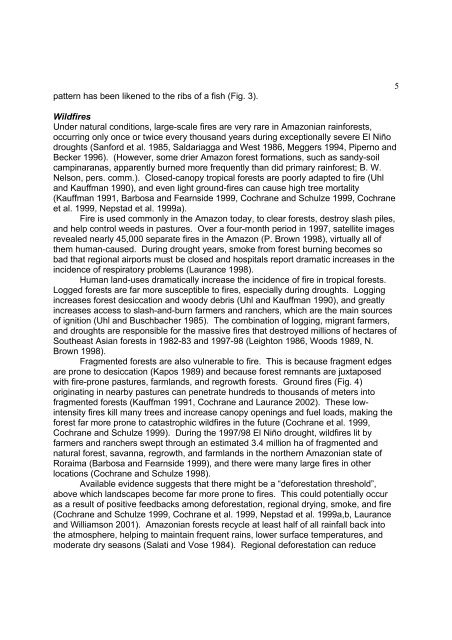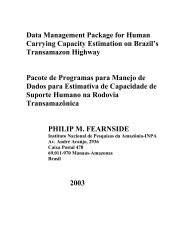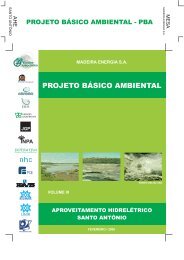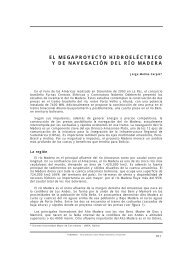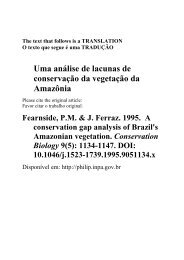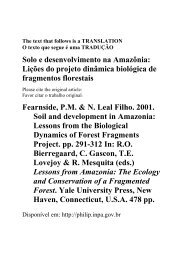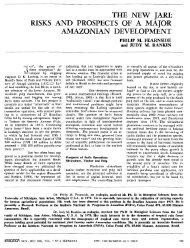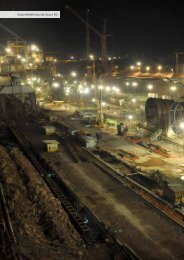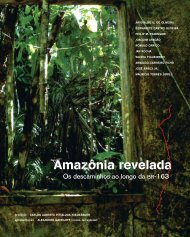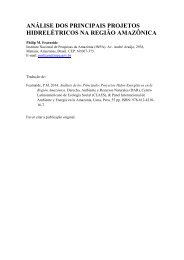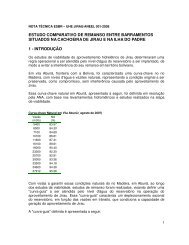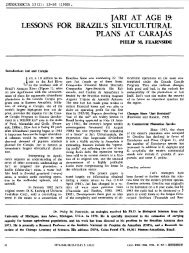THE FUTURE OF THE AMAZON - Philip M. Fearnside - Inpa
THE FUTURE OF THE AMAZON - Philip M. Fearnside - Inpa
THE FUTURE OF THE AMAZON - Philip M. Fearnside - Inpa
You also want an ePaper? Increase the reach of your titles
YUMPU automatically turns print PDFs into web optimized ePapers that Google loves.
pattern has been likened to the ribs of a fish (Fig. 3).5WildfiresUnder natural conditions, large-scale fires are very rare in Amazonian rainforests,occurring only once or twice every thousand years during exceptionally severe El Niñodroughts (Sanford et al. 1985, Saldariagga and West 1986, Meggers 1994, Piperno andBecker 1996). (However, some drier Amazon forest formations, such as sandy-soilcampinaranas, apparently burned more frequently than did primary rainforest; B. W.Nelson, pers. comm.). Closed-canopy tropical forests are poorly adapted to fire (Uhland Kauffman 1990), and even light ground-fires can cause high tree mortality(Kauffman 1991, Barbosa and <strong>Fearnside</strong> 1999, Cochrane and Schulze 1999, Cochraneet al. 1999, Nepstad et al. 1999a).Fire is used commonly in the Amazon today, to clear forests, destroy slash piles,and help control weeds in pastures. Over a four-month period in 1997, satellite imagesrevealed nearly 45,000 separate fires in the Amazon (P. Brown 1998), virtually all ofthem human-caused. During drought years, smoke from forest burning becomes sobad that regional airports must be closed and hospitals report dramatic increases in theincidence of respiratory problems (Laurance 1998).Human land-uses dramatically increase the incidence of fire in tropical forests.Logged forests are far more susceptible to fires, especially during droughts. Loggingincreases forest desiccation and woody debris (Uhl and Kauffman 1990), and greatlyincreases access to slash-and-burn farmers and ranchers, which are the main sourcesof ignition (Uhl and Buschbacher 1985). The combination of logging, migrant farmers,and droughts are responsible for the massive fires that destroyed millions of hectares ofSoutheast Asian forests in 1982-83 and 1997-98 (Leighton 1986, Woods 1989, N.Brown 1998).Fragmented forests are also vulnerable to fire. This is because fragment edgesare prone to desiccation (Kapos 1989) and because forest remnants are juxtaposedwith fire-prone pastures, farmlands, and regrowth forests. Ground fires (Fig. 4)originating in nearby pastures can penetrate hundreds to thousands of meters intofragmented forests (Kauffman 1991, Cochrane and Laurance 2002). These lowintensityfires kill many trees and increase canopy openings and fuel loads, making theforest far more prone to catastrophic wildfires in the future (Cochrane et al. 1999,Cochrane and Schulze 1999). During the 1997/98 El Niño drought, wildfires lit byfarmers and ranchers swept through an estimated 3.4 million ha of fragmented andnatural forest, savanna, regrowth, and farmlands in the northern Amazonian state ofRoraima (Barbosa and <strong>Fearnside</strong> 1999), and there were many large fires in otherlocations (Cochrane and Schulze 1998).Available evidence suggests that there might be a “deforestation threshold”,above which landscapes become far more prone to fires. This could potentially occuras a result of positive feedbacks among deforestation, regional drying, smoke, and fire(Cochrane and Schulze 1999, Cochrane et al. 1999, Nepstad et al. 1999a,b, Lauranceand Williamson 2001). Amazonian forests recycle at least half of all rainfall back intothe atmosphere, helping to maintain frequent rains, lower surface temperatures, andmoderate dry seasons (Salati and Vose 1984). Regional deforestation can reduce


